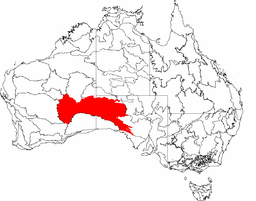Great Victoria desert
| Great Victoria | |
| Desert | |
|
The IBRA regions, with Great Victoria Desert in red
|
|
| Country | Australia |
|---|---|
| States | Western Australia, South Australia |
| Width | 700 km (435 mi), E/W |
| Area | 348,750 km2 (134,653 sq mi) |
| Biome | Desert |
The Great Victoria Desert, an interim Australian bioregion, is a sparsely populated desert area in Western Australia and South Australia.
The Great Victoria is the largest desert in Australia and consists of many small sandhills, grassland plains, areas with a closely packed surface of pebbles (called desert pavement or gibber plains) and salt lakes. It is over 700 kilometres (430 mi) wide (from west to east) and covers an area of 348,750 square kilometres (134,650 sq mi) from the Eastern Goldfields region of Western Australia to the Gawler Ranges in South Australia. The Western Australia Mallee shrub ecoregion lies to the west, the Little Sandy Desert to the northwest, the Gibson Desert and the Central Ranges xeric shrublands to the north, the Tirari and Sturt Stony deserts to the east, while the Nullarbor Plain to the south separates it from the Southern Ocean. Average annual rainfall is low and irregular, ranging from 200 to 250 mm (7.9 to 9.8 in) per year. Thunderstorms are relatively common in the Great Victoria Desert, with an average of 15–20 thunderstorms per annum. Summer daytime temperatures range from 32 to 40 °C (90 to 104 °F) while in winter, this falls to 18 to 23 °C (64 to 73 °F).
The majority of people living in the region are Indigenous Australians from different groups including the Kogara, the Mirning and the Pitjantjatjara. It is the part of Australia with the most populous and most healthy indigenous population. Aboriginal populations have been increasing in this region. Young Indigenous adults from the Great Victoria Desert region work in the Wilurarra Creative programs to maintain and develop their culture.
...
Wikipedia

